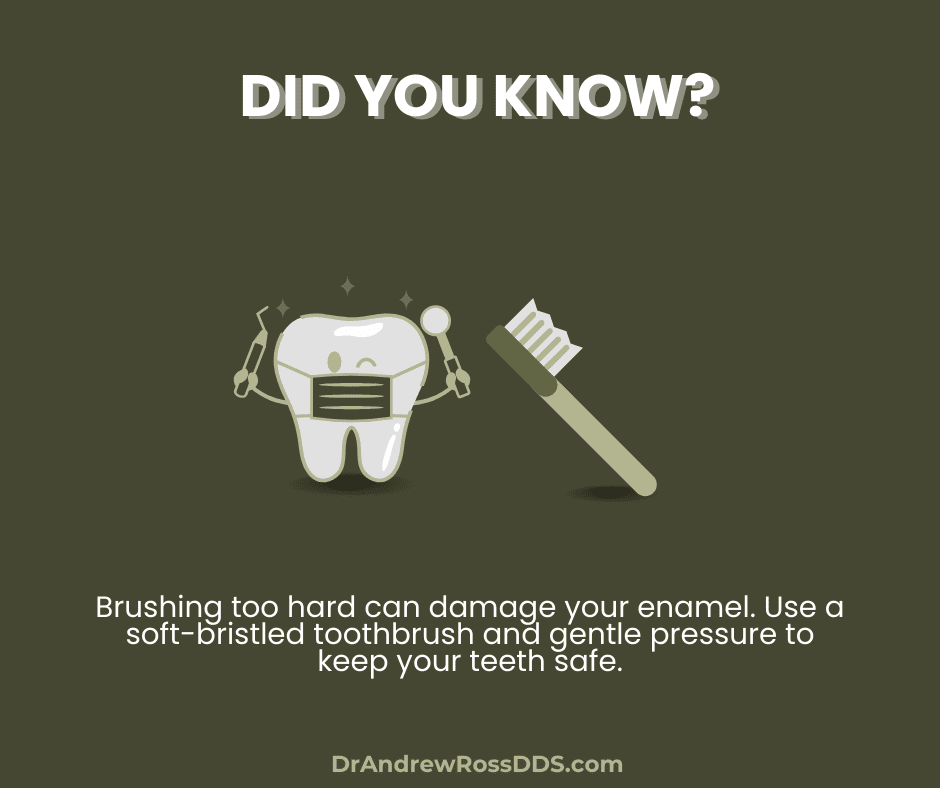Daily Dental Hygiene and Professional Teeth Cleaning

The cornerstone of optimal oral health is having healthy gums and teeth. This is accomplished by daily dental home care and regular dental cleanings/check-ups performed at our dental office.
Your role at home towards establishing a good oral hygiene routine begins with a daily tooth care regimen. The best at-home routine includes daily brushing and flossing.
Brushing Your Teeth
Brushing is done using a soft bristled toothbrush (or extra soft) and a fluoride containing toothpaste for two minutes. Theoretically, this should be done after every meal and snack, but can damage the teeth and gums if an improper technique is used. Minimally brush twice daily, after breakfast and after dinner. And, in a worst case scenario, if only done once daily, then brush after dinner or, if eating an after dinner snack, then brush after it or before bedtime.
Flossing
Brushing and flossing go hand in hand with each other, so every time you brush, you should floss. You must floss between all teeth making contact with each other. The area between the teeth accounts for approximately one third of the surface area of all teeth in your mouth. So, if you only brush, you are only cleaning two thirds of your teeth.
Taking time each day to complete this simple routine can help you avoid serious problems such as gum disease and tooth decay. However, this daily routine by itself is generally not enough to keep your mouth completely healthy. This is why you must see the hygienist and dentist regularly for cleanings and check-ups.
Regular Office Visits
An essential part of your oral hygiene routine is visits to our Visalia office every six months for general dentistry services. Your semiannual visits will include a professional tooth cleaning and fluoride treatment performed by one of our experienced Registered Dental Hygienists along with a thorough examination done by Dr. Andrew Ross to ensure the highest level of care. However, not all dental issues can be managed with biannual office visits. In some cases, it is best for patients to be seen every three to four months to manage their gum disease, especially if tartar builds up quickly or there is a history of bone loss around the teeth.
Our professional cleanings involve the use of various cleaning instruments, such as ultrasonic scalers and hand instruments, to loosen and remove deposits of mineralized plaque (tartar and calculus) above and below the gum line. These deposits may develop even with the most careful of daily brushing and flossing routines, especially in areas that are difficult to reach.
During these semiannual visits, digital x-rays (which expose our patients to less radiation than conventional x-rays) and other diagnostic tools are utilized as needed to help screen and guard against oral health issues that can occur even when the most thorough at-home care routine is followed. If a problem is detected, Dr. Andrew Ross can customize a treatment solution to help ensure your teeth and gums stay healthy and strong.
The Body/Mouth Connection
Diseases and disorders that develop in your mouth can have far reaching systemic consequences. Research has found that gum diseases can contribute to systemic diseases, such as hypertension, heart disease, and complications with pregnancy, just to name a few. Common disorders such a temporomandibular joint (TMJ) dysfunction, which are often first diagnosed during your initial exam or during your regular dental check-up visits, can lead to problems such as facial pain, back and neck aches, postural changes, and digestive issues. These and other serious systemic health issues, where the oral cavity can contribute to the problem, can be minimized or avoided by taking time every six months to visit our caring office staff, making these visits an important part of your dental and overall healthcare routine.
Teeth Whitening
Whitening the teeth with a bleaching solution is a simple and effective method to help whiten teeth that are stained and discolored. Whitening does not change the color of existing fillings or crowns. The results of whitening will vary from person to person, and some people can develop sensitivity while bleaching, but it is generally minimal or lasts only a limited time.
At our office, there are two principal ways to whiten your teeth. We can whiten your teeth at the office, which takes about an hour, and have you follow it up at home using your custom bleaching trays. Alternatively, you can choose to do the treatment at home on your own using the trays. Both methods produce the same results. Initiating the process at our office, which is advised for first time users, speeds up the process (one office visit is about equal to four at home sessions) and allows us to identify any complications, such as sensitivity.
Custom bleaching trays are carefully fabricated from impressions of your teeth. These trays are designed to allow for an optimum distribution of bleaching solution around your teeth to provide the best results and prevent the solution from irritating the gums while it works. These trays are also reusable for when you decide to do the bleaching process again.
Prescription strength bleaching solutions are used with your custom trays. These solutions are efficient, effective, safe, and have mediators in the solution to minimize or eliminate sensitivity. Additionally, adjuncts for the bleaching process can be used, which further decreases the chances of getting sensitivity and also tends to increase the length of time the teeth stay white after the bleaching process. Our prescription bleaching solutions generally require seven to ten consecutive days of use at home, about an hour a day, to get the results desired. However, this length of time varies from person to person.
Preventative Dentistry
We want to help keep your teeth clean and healthy!
Emergency? Call ASAP
Prompt treatment is always required to alleviate pain and to ensure your teeth have the best possible chance of survival.
